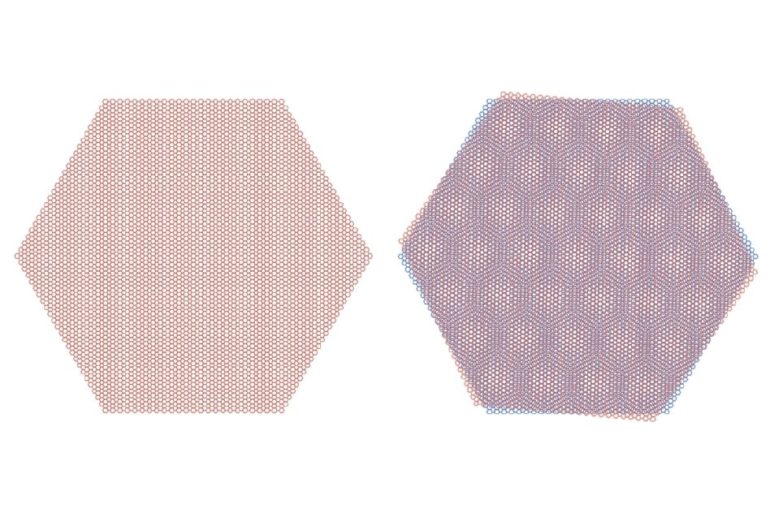For some 50 years scientists have worked to harness Bloch oscillations, an exotic kind of behavior by electrons that could introduce a new field of physics—and important new technologies—much like more conventional electronic behavior has led to everything from smart watches to computers powerful enough to get us to the Moon.
Now, MIT physicists report on a new approach to achieving Bloch oscillations in recently introduced graphene superlattices. Graphene, a material composed of a single layer of carbon atoms arranged in hexagons resembling a honeycomb structure, is an excellent conductor of electricity. Its electronic properties undergo an interesting transformation in the presence of an “electric mesh” (a periodic potential), resulting in new types of electron behavior not seen in pristine materials. In a recent issue of Physical Review Letters, the scientists outline why graphene superlattices may be game changers in the pursuit of Bloch oscillations.
Normally, electrons exposed to a constant electric field accelerate in a straight line. However, quantum mechanics predicts that electrons in a crystal, or material composed of atoms arranged in an orderly fashion, can behave differently. Upon exposure to an electric field, they can oscillate in tiny waves—Bloch oscillations. “This surprising behavior is an iconic example of coherent dynamics in quantum many-body systems,” says Leonid Levitov, an MIT professor of physics and leader of the current work. Levitov is also affiliated with MIT’s Materials Research Laboratory.
Additional authors are Ali Fahimniya and Zhiyu Dong, both MIT graduate students in physics, and Egor I. Kiselev of Karlsruher Institut fur Technologie.
Toward new applications
Importantly, Bloch oscillations occur at a frequency value that is the same for all electrons and is tunable by the applied electric field. Further, typical frequency values—in the terahertz range, or trillions of cycles per second—are in the range that is difficult to access via conventional means. Today’s electronics and optics work at frequencies below and above the terahertz, respectively. “Terahertz frequencies are something in between, and we’re not benefiting from them as much as from the rest of the spectrum,” Levitov says. “If we could easily access them, there could be many applications, ranging from better non-invasive security scanning at airports to new electronics designs.”
Because of the interesting physics and potential applications of Bloch oscillations, over the years many scientists have tried to demonstrate the behavior. Bloch oscillations, however, are very sensitive to scattering processes in the material due to lattice vibrations (phonons) and disorder. As a result, although earlier work aimed at creating Bloch oscillations was extremely important—one approach, relying on semiconducting superlattices, led to a Nobel Prize and modern-day solid-state lasers—it met with only limited success toward its original goal. “People did see signatures of Bloch oscillations in these systems, but not at the level that would be useful for anything practical. There was inevitably some dephasing, which turned out to be pretty damning [for the phenomenon],” Levitov says.
A new material
Enter a new material known as moiré graphene. Pioneered at MIT by Physics Professor Pablo Jarillo-Herrero, moiré graphene is composed of two sheets of atomically thin layers of graphene placed on top of each other and rotated at a slight angle. “And according to theory, this material should be an ideal candidate for seeing Bloch oscillations,” Levitov says. In the recent paper, he and colleagues analyzed the material’s parameters that impact how electrons move in it and how little disorder it has, and “we show that on all accounts, moiré graphene is as good as the semiconducting superlattices, or better.”
Furthermore, other appealing varieties of superlattices have appeared recently, involving graphene paired with hexagonal boron nitride, or with patterned dielectric superlattices. Among additional advantages, graphene superlattices are much easier to make than the complicated structures key to the earlier work. “Those systems were produced by only a few highly qualified groups around the world,” Levitov says. Moiré graphene is already being made by several groups in the US alone, and many more worldwide.
Finally, Levitov and colleagues say, moiré graphene meets another important criterion for making Bloch oscillations practical. While the electrons involved in the oscillations do so at the same terahertz frequency, without a little help they’ll do so independently. The key is to coax them to oscillate in synchrony. “If you can do that, then you go from essentially a one-electron phenomenon to macroscopic oscillations that will be easily detectable and very usable because they will become a source of macroscopic current,” Levitov says. The scientists believe that the electrons in moiré graphene should be quite amenable to synchronization using standard techniques.
Dmitri Basov, Higgins Professor and Chair of Physics at Columbia University, comments, “Like many other predictions by Leonid Levitov and his team, this new result on Bloch oscillations will most certainly motivate numerous experimental studies. I predict it will not be easy to observe Bloch oscillations in moiré flat band systems, but we will certainly try.” Basov was not involved in the work reported in Physical Review Letters.
Levitov is excited about continuing the work, which will include MIT undergraduates. “The best part of this will come later when we see experimental results that prove the idea,” he says.
A new beat in quantum matter
More information:
Ali Fahimniya et al, Synchronizing Bloch-Oscillating Free Carriers in Moiré Flat Bands, Physical Review Letters (2021). DOI: 10.1103/PhysRevLett.126.256803
Provided by
Materials Research Laboratory, Massachusetts Institute of Technology
Citation:
Physicists report promising approach to harnessing exotic electronic behavior (2021, October 5)
retrieved 6 October 2021
from https://phys.org/news/2021-10-physicists-approach-harnessing-exotic-electronic.html
This document is subject to copyright. Apart from any fair dealing for the purpose of private study or research, no
part may be reproduced without the written permission. The content is provided for information purposes only.



